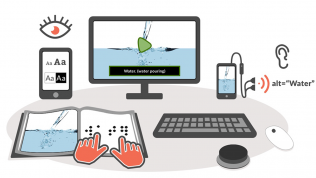
Designing for Accessibility with POUR
The WCAG guidelines are written in technical language that can be confusing to even veteran developers. Fortunately, they can be distilled into a set of simpler principles, as captured by the acronym POUR, that define four qualities of an accessible user experience.
Many of the learning materials educators use in the classroom are self-created. This has been made possible by the greater availability and improved ease of use of authoring tools. These tools now often include options for adding accessibility into the content creation workflow, and standards such as the Web Content Accessibility Guidelines (WCAG) provide guidance for how to do so. WCAG, which is now at version 2.1, is the international standard for making web content accessible. It is the foundation for many national accessibility laws, including Section 508 in the U.S.
The WCAG guidelines are written in technical language that can be confusing to even veteran developers. Fortunately, they can be distilled into a set of simpler principles, as captured by the acronym POUR, that define four qualities of an accessible user experience.
Share this resource:
Posted date:
July 26, 2021
